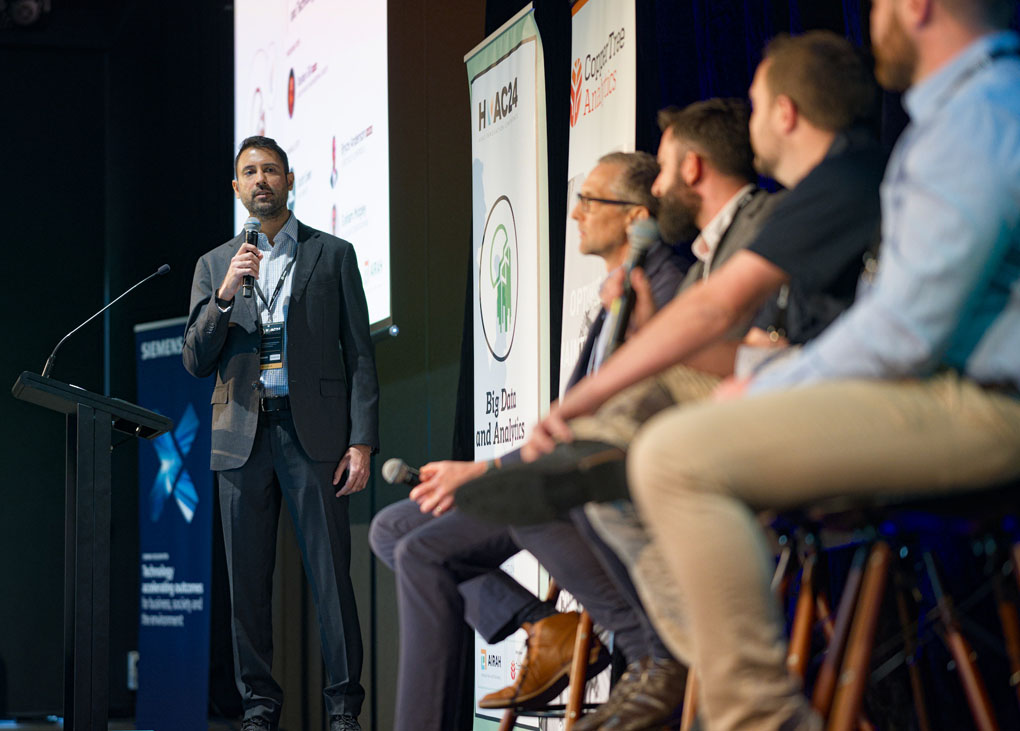AIRAH’s 2024 HVAC Innovation Conference (HVAC24) marked the first time the Institute has held three of its marquee events concurrently: the Future of HVAC Conference, the Building Physics Forum, and the Big Data and Analytics Forum.
With a record 265 attendees and more than 60 presenters, the conference was a runaway success. One of the standouts for many attendees was the ability to switch between conference streams easily, allowing them to choose which sessions they go to, learn things that might be well outside their typical area of expertise, and make important new connections.
We take a look back at some of the highlights and key themes to emerge from last week’s event in Brisbane.
AI is here to stay
With key themes like the future of HVAC and big data and analytics, it’s no surprise that AI was high on the agenda at the conference. What did surprise many attendees were the bold predictions of the first keynote speaker, Craig Rispin.
Rispin is a futurist, a business mentor, and a passionate advocate for using AI to aid workers and support business growth. He explained how he used AI to put together his spectacular presentation, which predicted enormous growth in the HVAC industry, especially in the emerging markets of India, China, and Indonesia.
One of Rispin’s key messages was that there are two types of businesses: those that embrace industry-changing technologies like AI, and those that don’t exist anymore. Judging by the audience’s reaction, we’re not far away from seeing a huge uptake in AI within the HVAC&R industry.
Practical AI applications are already here
While Rispin’s high-concept presentation was full of razzle dazzle, Louka Ewington-Pitsos took a more-down-to-earth approach towards his presentation in the Big Data and Analytics stream.
Ewington-Pitsos is data science consultant who has founded two successful machine learning startups. His presentation focused on the distinction between the different subcategories of AI, in particular between generative AI and machine learning.
Ewington-Pitsos emphasised his belief that, while companies often use AI as a marketing buzzword, those who have years of proven experience in machine learning can produce tremendous real-world results. He then used a simple example to explain how machine learning works and the kind of applications it could have in HVAC&R.
Immediately following this was a demonstration of exactly that by Noel Courtney, M.AIRAH. Courtney explained how his business has adopted AI to dramatically improve efficiency in HVAC maintenance and repair, providing better results to end-users and dramatically increasing the efficiency of the company’s workforce. The 10-minute Q&A session could have easily lasted for another 20 as the audience picked Courtney’s brain on this successful application.
Building physics and IAQ are inextricably linked
If there was one theme that rang loud and clear from the Building Physics Forum, it was the importance of good building design for preventing mould growth and other factors that can affect indoor air quality.
Villy Yordanov, Affil.AIRAH, gave a captivating presentation explaining the connections between insulation and mould growth on precast concrete. Yordanov’s eye-catching and informative illustrations clearly showed how and why certain insulation strategies promote condensation and mould growth on concrete, as well as the consequences for buildings that aren’t designed to abate this problem.
As Yordanov explained, there are many ways to insulate precast concrete incorrectly, and only one or two ways to get it right. But for the health of the building and its occupants, solving these issues isn’t optional.
Other highlights from the forum included Dr Mark Drewsbury, M.AIRAH, who talked about the challenges facing residential building envelopes, and Marcus Strang, a Passivhaus expert who shared the findings from his research into moisture-safe energy efficient CLT assemblies in hot and humid climates.
There’s nothing like remote HVAC to challenge your skills
Two of the most memorable sessions at HVAC24 came from Sonia Holzheimer, M.AIRAH, and Sean Maxwell, M.AIRAH, both of whom shared case studies from the harshest, most remote locations imaginable.
Holzheimer asked the audience to imagine what they would need to build an HVAC system on Mars. While her case study wasn’t actually from the red planet, it was about as close as you can get on Earth. She talked about her company’s most challenging assignment, which was to work on an HVAC system on Willis Island.
The tiny island is 18 hours by boat from the Queensland mainland, and is just big enough to host Australia’s most remote weather station. The HVAC system was suffering from all kinds of problems, including horrendous odours from the huge volume of bird guano on the island.
Holzheimer explained how her team planned for the mission, which areas they succeeded in, and the challenges that remained after the adventure. One thing’s for sure: remote jobs like this aren’t for the faint-hearted.
Maxwell faced similar challenges on a project in outback South Australia, about 12 hours’ drive from Adelaide. His task was to help retrofit social housing that was offering little resistance against the extreme highs and lows of desert temperatures.
The challenges Maxwell faced were numerous: everything from thick dust and rat damage to communication barriers when it came to occupant usage of the houses and HVAC systems. Problems that he could solve easily in the city with a trip to the local hardware store were nigh on impossible in the outback, requiring specialist equipment, long waits for delivery, and expensive labour.
Despite the difficulties, Maxwell described the ongoing project as extremely satisfying, and one that has taught him plenty about life in Australia’s harshest environments.
 Nick Johns-Wickberg
Nick Johns-Wickberg







Leave a Reply